Leadership and Operations Management Analysis: M&S Ltd Case Study
VerifiedAdded on 2020/10/05
|17
|4581
|486
Report
AI Summary
This report provides a comprehensive analysis of leadership and operations management at M&S Ltd. It begins with an introduction to the company and its management structure, followed by an examination of the roles and characteristics of leaders and managers. The report delves into the differences between managerial functions and leadership roles, applying various management theories such as system theory, scientific theory, and human relation theory. It explores the roles of leaders and managers in different situations, including increasing productivity, improving product quality, and resolving conflicts. Furthermore, the report discusses different theories and approaches to management and leadership, such as situational leadership, system leadership, and contingency leadership, along with their respective strengths and weaknesses. The second part of the report focuses on operations management, covering key approaches like the lean approach, Six Sigma, and Total Quality Management (TQM). It highlights the roles and responsibilities of leaders and managers in successfully managing operations, emphasizing the importance and value of these approaches. The report concludes with recommendations for M&S Ltd based on the analysis.
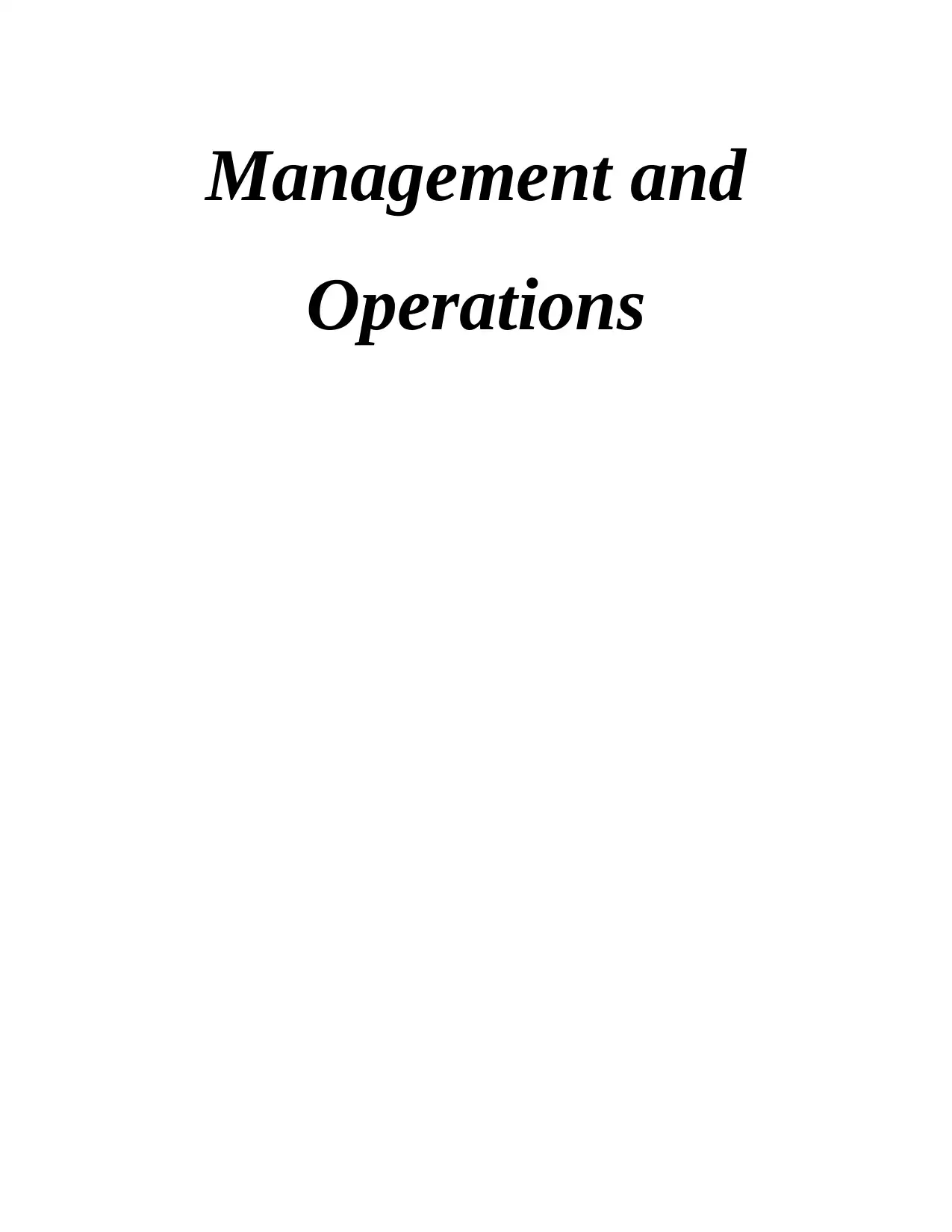
Management and
Operations
Operations
Paraphrase This Document
Need a fresh take? Get an instant paraphrase of this document with our AI Paraphraser
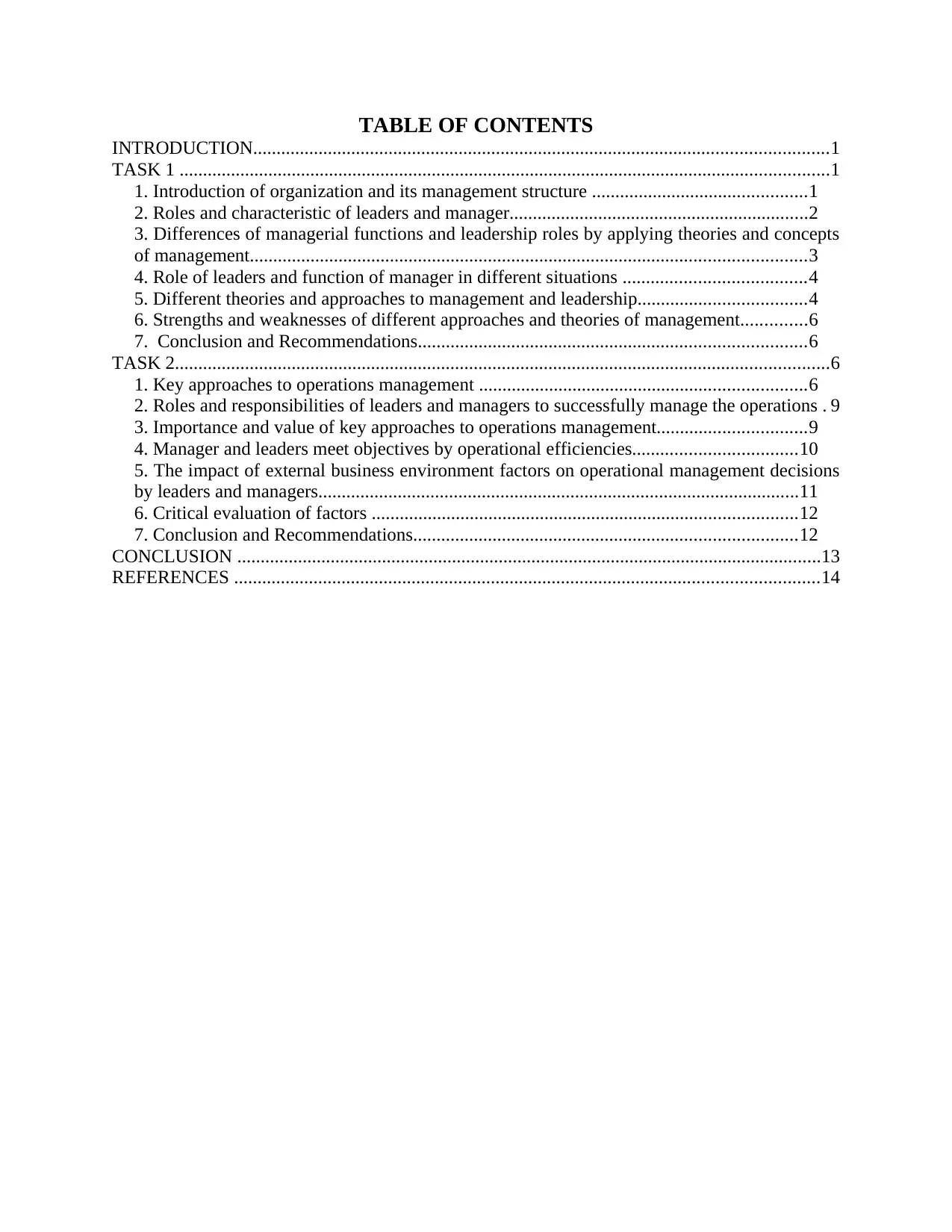
TABLE OF CONTENTS
INTRODUCTION...........................................................................................................................1
TASK 1 ...........................................................................................................................................1
1. Introduction of organization and its management structure ..............................................1
2. Roles and characteristic of leaders and manager................................................................2
3. Differences of managerial functions and leadership roles by applying theories and concepts
of management.......................................................................................................................3
4. Role of leaders and function of manager in different situations .......................................4
5. Different theories and approaches to management and leadership....................................4
6. Strengths and weaknesses of different approaches and theories of management..............6
7. Conclusion and Recommendations...................................................................................6
TASK 2............................................................................................................................................6
1. Key approaches to operations management ......................................................................6
2. Roles and responsibilities of leaders and managers to successfully manage the operations . 9
3. Importance and value of key approaches to operations management................................9
4. Manager and leaders meet objectives by operational efficiencies...................................10
5. The impact of external business environment factors on operational management decisions
by leaders and managers.......................................................................................................11
6. Critical evaluation of factors ...........................................................................................12
7. Conclusion and Recommendations..................................................................................12
CONCLUSION .............................................................................................................................13
REFERENCES .............................................................................................................................14
INTRODUCTION...........................................................................................................................1
TASK 1 ...........................................................................................................................................1
1. Introduction of organization and its management structure ..............................................1
2. Roles and characteristic of leaders and manager................................................................2
3. Differences of managerial functions and leadership roles by applying theories and concepts
of management.......................................................................................................................3
4. Role of leaders and function of manager in different situations .......................................4
5. Different theories and approaches to management and leadership....................................4
6. Strengths and weaknesses of different approaches and theories of management..............6
7. Conclusion and Recommendations...................................................................................6
TASK 2............................................................................................................................................6
1. Key approaches to operations management ......................................................................6
2. Roles and responsibilities of leaders and managers to successfully manage the operations . 9
3. Importance and value of key approaches to operations management................................9
4. Manager and leaders meet objectives by operational efficiencies...................................10
5. The impact of external business environment factors on operational management decisions
by leaders and managers.......................................................................................................11
6. Critical evaluation of factors ...........................................................................................12
7. Conclusion and Recommendations..................................................................................12
CONCLUSION .............................................................................................................................13
REFERENCES .............................................................................................................................14
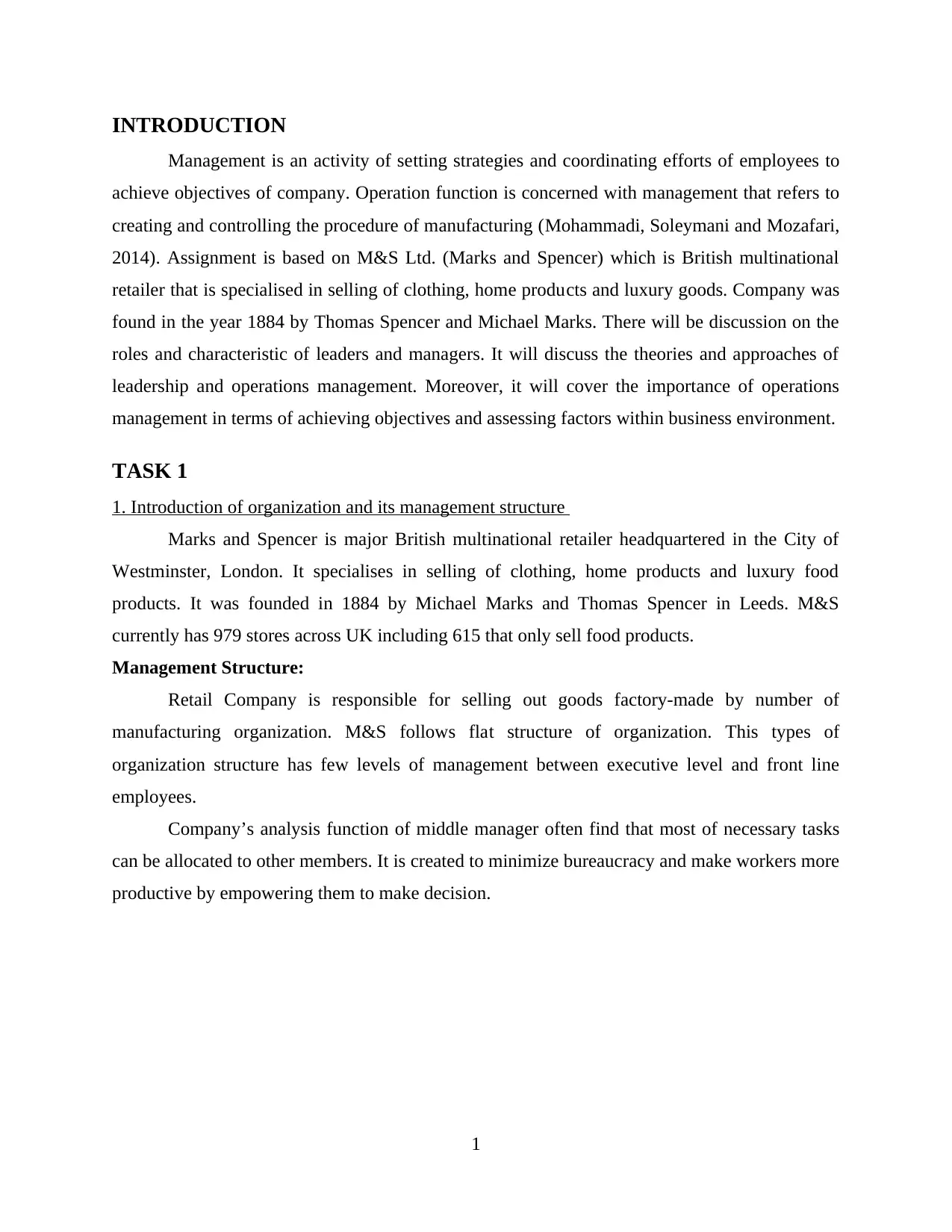
INTRODUCTION
Management is an activity of setting strategies and coordinating efforts of employees to
achieve objectives of company. Operation function is concerned with management that refers to
creating and controlling the procedure of manufacturing (Mohammadi, Soleymani and Mozafari,
2014). Assignment is based on M&S Ltd. (Marks and Spencer) which is British multinational
retailer that is specialised in selling of clothing, home products and luxury goods. Company was
found in the year 1884 by Thomas Spencer and Michael Marks. There will be discussion on the
roles and characteristic of leaders and managers. It will discuss the theories and approaches of
leadership and operations management. Moreover, it will cover the importance of operations
management in terms of achieving objectives and assessing factors within business environment.
TASK 1
1. Introduction of organization and its management structure
Marks and Spencer is major British multinational retailer headquartered in the City of
Westminster, London. It specialises in selling of clothing, home products and luxury food
products. It was founded in 1884 by Michael Marks and Thomas Spencer in Leeds. M&S
currently has 979 stores across UK including 615 that only sell food products.
Management Structure:
Retail Company is responsible for selling out goods factory-made by number of
manufacturing organization. M&S follows flat structure of organization. This types of
organization structure has few levels of management between executive level and front line
employees.
Company’s analysis function of middle manager often find that most of necessary tasks
can be allocated to other members. It is created to minimize bureaucracy and make workers more
productive by empowering them to make decision.
1
Management is an activity of setting strategies and coordinating efforts of employees to
achieve objectives of company. Operation function is concerned with management that refers to
creating and controlling the procedure of manufacturing (Mohammadi, Soleymani and Mozafari,
2014). Assignment is based on M&S Ltd. (Marks and Spencer) which is British multinational
retailer that is specialised in selling of clothing, home products and luxury goods. Company was
found in the year 1884 by Thomas Spencer and Michael Marks. There will be discussion on the
roles and characteristic of leaders and managers. It will discuss the theories and approaches of
leadership and operations management. Moreover, it will cover the importance of operations
management in terms of achieving objectives and assessing factors within business environment.
TASK 1
1. Introduction of organization and its management structure
Marks and Spencer is major British multinational retailer headquartered in the City of
Westminster, London. It specialises in selling of clothing, home products and luxury food
products. It was founded in 1884 by Michael Marks and Thomas Spencer in Leeds. M&S
currently has 979 stores across UK including 615 that only sell food products.
Management Structure:
Retail Company is responsible for selling out goods factory-made by number of
manufacturing organization. M&S follows flat structure of organization. This types of
organization structure has few levels of management between executive level and front line
employees.
Company’s analysis function of middle manager often find that most of necessary tasks
can be allocated to other members. It is created to minimize bureaucracy and make workers more
productive by empowering them to make decision.
1
⊘ This is a preview!⊘
Do you want full access?
Subscribe today to unlock all pages.

Trusted by 1+ million students worldwide
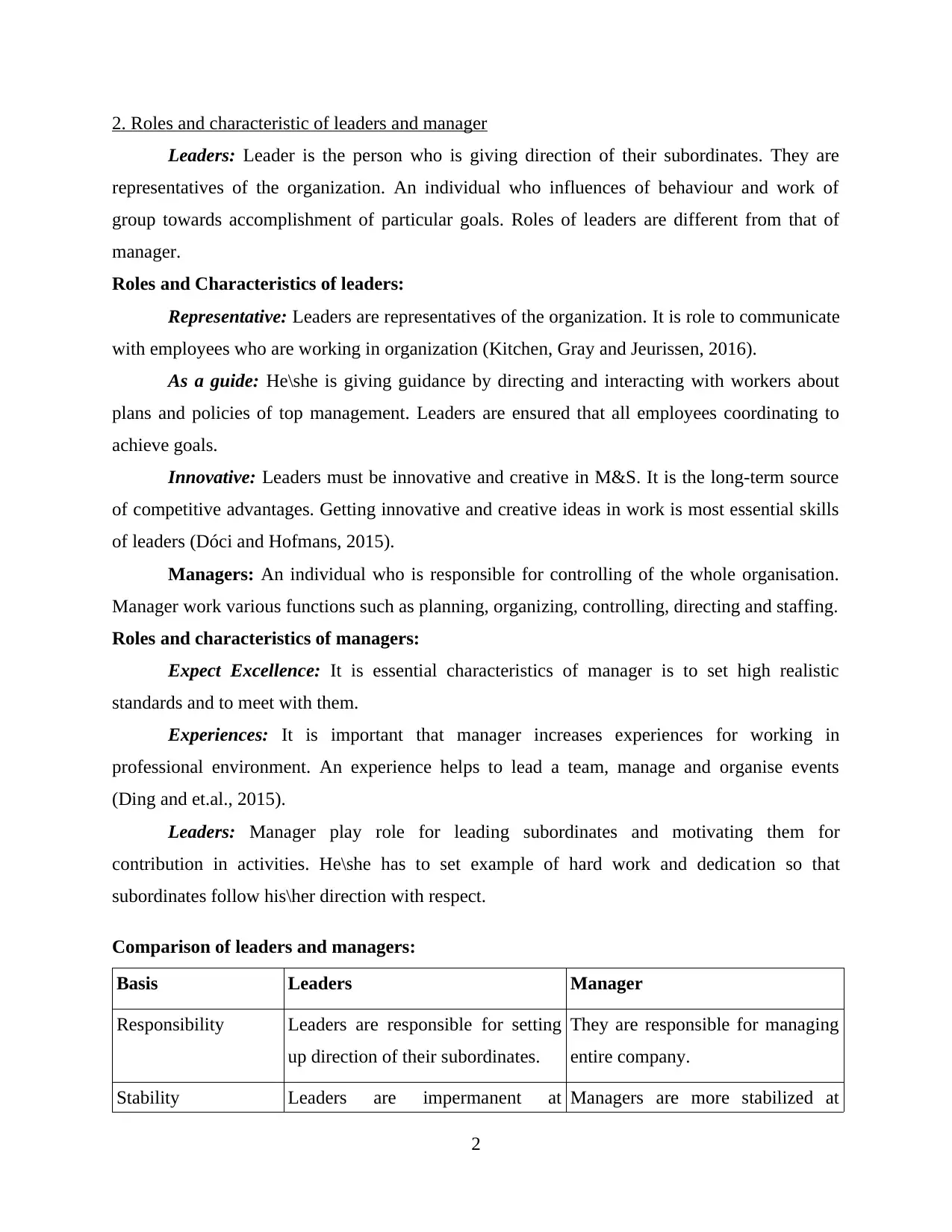
2. Roles and characteristic of leaders and manager
Leaders: Leader is the person who is giving direction of their subordinates. They are
representatives of the organization. An individual who influences of behaviour and work of
group towards accomplishment of particular goals. Roles of leaders are different from that of
manager.
Roles and Characteristics of leaders:
Representative: Leaders are representatives of the organization. It is role to communicate
with employees who are working in organization (Kitchen, Gray and Jeurissen, 2016).
As a guide: He\she is giving guidance by directing and interacting with workers about
plans and policies of top management. Leaders are ensured that all employees coordinating to
achieve goals.
Innovative: Leaders must be innovative and creative in M&S. It is the long-term source
of competitive advantages. Getting innovative and creative ideas in work is most essential skills
of leaders (Dóci and Hofmans, 2015).
Managers: An individual who is responsible for controlling of the whole organisation.
Manager work various functions such as planning, organizing, controlling, directing and staffing.
Roles and characteristics of managers:
Expect Excellence: It is essential characteristics of manager is to set high realistic
standards and to meet with them.
Experiences: It is important that manager increases experiences for working in
professional environment. An experience helps to lead a team, manage and organise events
(Ding and et.al., 2015).
Leaders: Manager play role for leading subordinates and motivating them for
contribution in activities. He\she has to set example of hard work and dedication so that
subordinates follow his\her direction with respect.
Comparison of leaders and managers:
Basis Leaders Manager
Responsibility Leaders are responsible for setting
up direction of their subordinates.
They are responsible for managing
entire company.
Stability Leaders are impermanent at Managers are more stabilized at
2
Leaders: Leader is the person who is giving direction of their subordinates. They are
representatives of the organization. An individual who influences of behaviour and work of
group towards accomplishment of particular goals. Roles of leaders are different from that of
manager.
Roles and Characteristics of leaders:
Representative: Leaders are representatives of the organization. It is role to communicate
with employees who are working in organization (Kitchen, Gray and Jeurissen, 2016).
As a guide: He\she is giving guidance by directing and interacting with workers about
plans and policies of top management. Leaders are ensured that all employees coordinating to
achieve goals.
Innovative: Leaders must be innovative and creative in M&S. It is the long-term source
of competitive advantages. Getting innovative and creative ideas in work is most essential skills
of leaders (Dóci and Hofmans, 2015).
Managers: An individual who is responsible for controlling of the whole organisation.
Manager work various functions such as planning, organizing, controlling, directing and staffing.
Roles and characteristics of managers:
Expect Excellence: It is essential characteristics of manager is to set high realistic
standards and to meet with them.
Experiences: It is important that manager increases experiences for working in
professional environment. An experience helps to lead a team, manage and organise events
(Ding and et.al., 2015).
Leaders: Manager play role for leading subordinates and motivating them for
contribution in activities. He\she has to set example of hard work and dedication so that
subordinates follow his\her direction with respect.
Comparison of leaders and managers:
Basis Leaders Manager
Responsibility Leaders are responsible for setting
up direction of their subordinates.
They are responsible for managing
entire company.
Stability Leaders are impermanent at Managers are more stabilized at
2
Paraphrase This Document
Need a fresh take? Get an instant paraphrase of this document with our AI Paraphraser
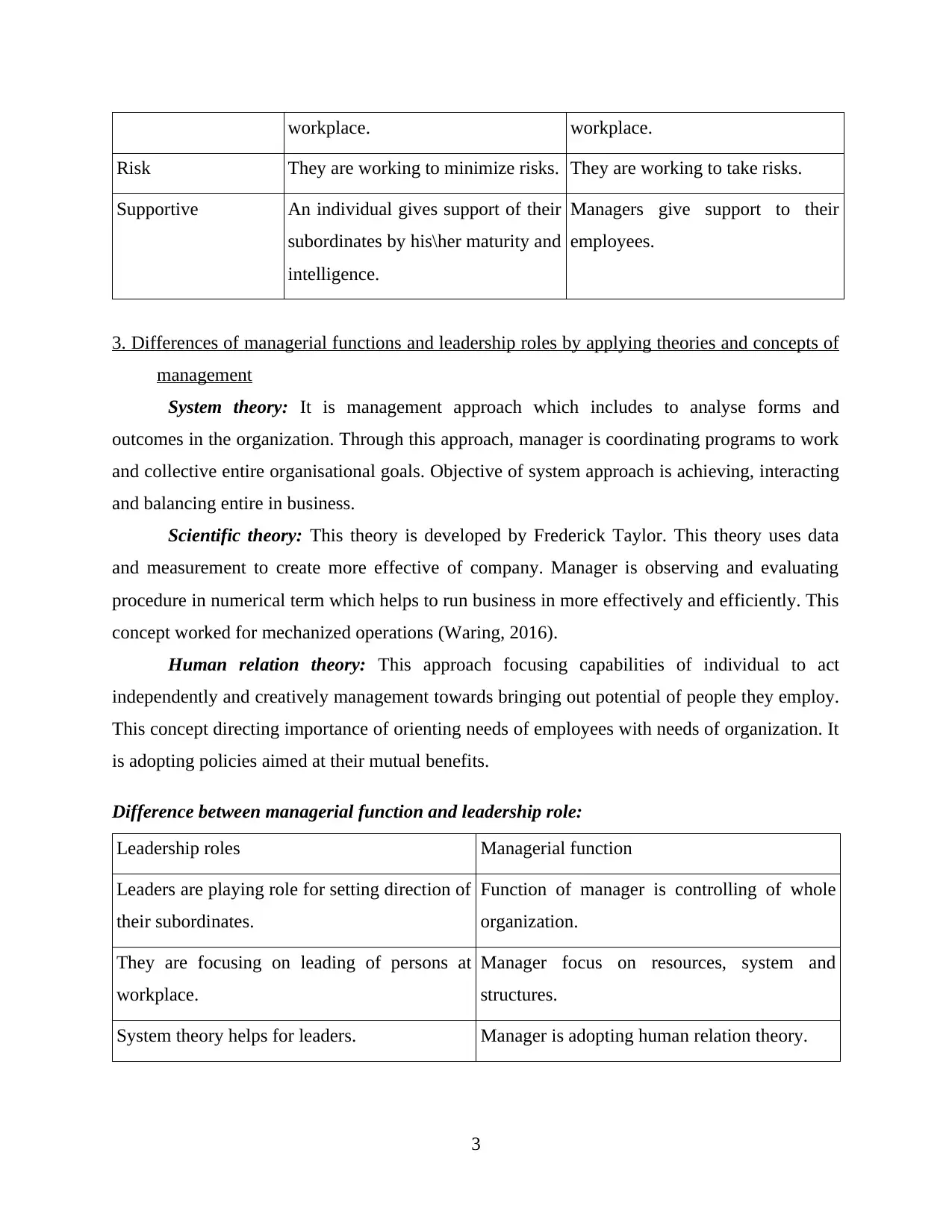
workplace. workplace.
Risk They are working to minimize risks. They are working to take risks.
Supportive An individual gives support of their
subordinates by his\her maturity and
intelligence.
Managers give support to their
employees.
3. Differences of managerial functions and leadership roles by applying theories and concepts of
management
System theory: It is management approach which includes to analyse forms and
outcomes in the organization. Through this approach, manager is coordinating programs to work
and collective entire organisational goals. Objective of system approach is achieving, interacting
and balancing entire in business.
Scientific theory: This theory is developed by Frederick Taylor. This theory uses data
and measurement to create more effective of company. Manager is observing and evaluating
procedure in numerical term which helps to run business in more effectively and efficiently. This
concept worked for mechanized operations (Waring, 2016).
Human relation theory: This approach focusing capabilities of individual to act
independently and creatively management towards bringing out potential of people they employ.
This concept directing importance of orienting needs of employees with needs of organization. It
is adopting policies aimed at their mutual benefits.
Difference between managerial function and leadership role:
Leadership roles Managerial function
Leaders are playing role for setting direction of
their subordinates.
Function of manager is controlling of whole
organization.
They are focusing on leading of persons at
workplace.
Manager focus on resources, system and
structures.
System theory helps for leaders. Manager is adopting human relation theory.
3
Risk They are working to minimize risks. They are working to take risks.
Supportive An individual gives support of their
subordinates by his\her maturity and
intelligence.
Managers give support to their
employees.
3. Differences of managerial functions and leadership roles by applying theories and concepts of
management
System theory: It is management approach which includes to analyse forms and
outcomes in the organization. Through this approach, manager is coordinating programs to work
and collective entire organisational goals. Objective of system approach is achieving, interacting
and balancing entire in business.
Scientific theory: This theory is developed by Frederick Taylor. This theory uses data
and measurement to create more effective of company. Manager is observing and evaluating
procedure in numerical term which helps to run business in more effectively and efficiently. This
concept worked for mechanized operations (Waring, 2016).
Human relation theory: This approach focusing capabilities of individual to act
independently and creatively management towards bringing out potential of people they employ.
This concept directing importance of orienting needs of employees with needs of organization. It
is adopting policies aimed at their mutual benefits.
Difference between managerial function and leadership role:
Leadership roles Managerial function
Leaders are playing role for setting direction of
their subordinates.
Function of manager is controlling of whole
organization.
They are focusing on leading of persons at
workplace.
Manager focus on resources, system and
structures.
System theory helps for leaders. Manager is adopting human relation theory.
3
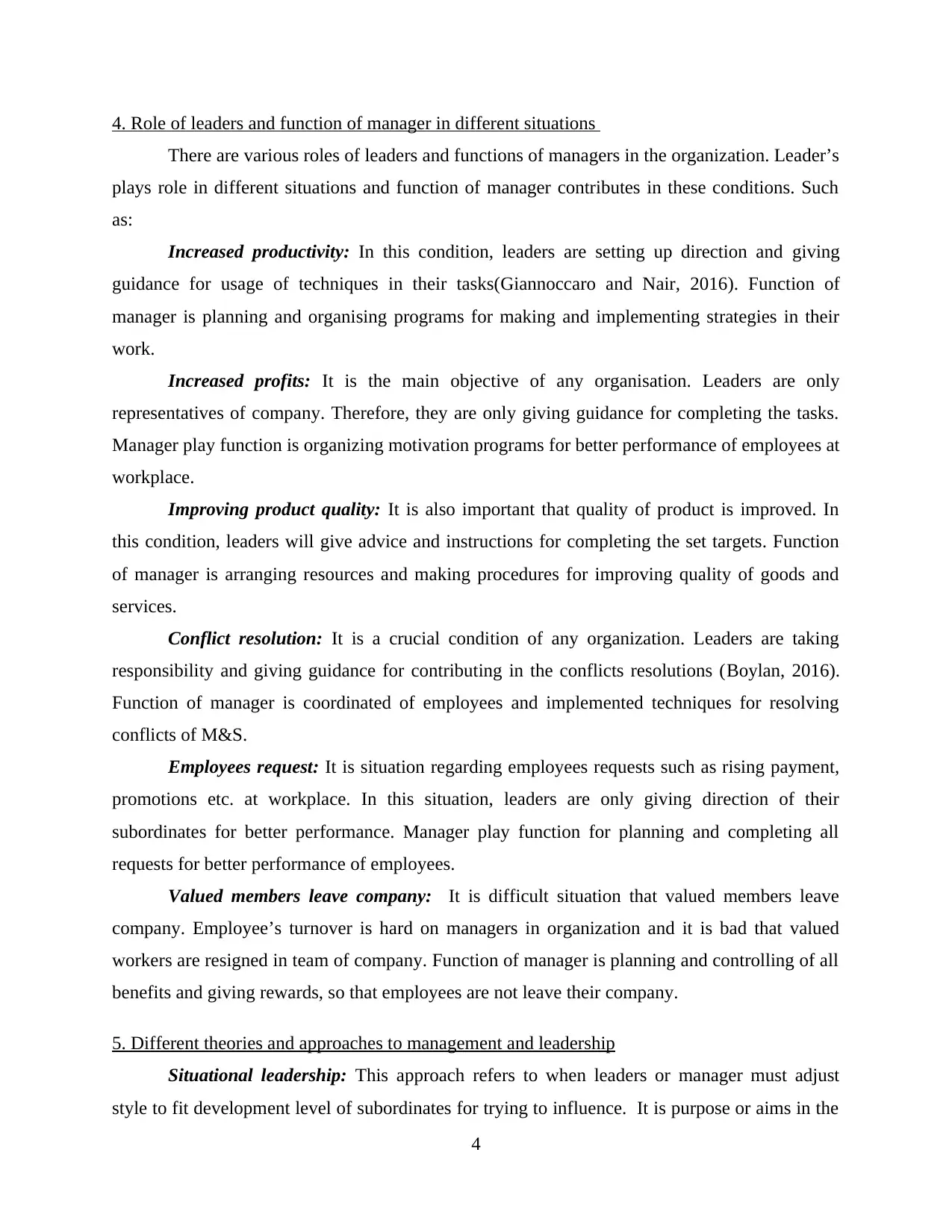
4. Role of leaders and function of manager in different situations
There are various roles of leaders and functions of managers in the organization. Leader’s
plays role in different situations and function of manager contributes in these conditions. Such
as:
Increased productivity: In this condition, leaders are setting up direction and giving
guidance for usage of techniques in their tasks(Giannoccaro and Nair, 2016). Function of
manager is planning and organising programs for making and implementing strategies in their
work.
Increased profits: It is the main objective of any organisation. Leaders are only
representatives of company. Therefore, they are only giving guidance for completing the tasks.
Manager play function is organizing motivation programs for better performance of employees at
workplace.
Improving product quality: It is also important that quality of product is improved. In
this condition, leaders will give advice and instructions for completing the set targets. Function
of manager is arranging resources and making procedures for improving quality of goods and
services.
Conflict resolution: It is a crucial condition of any organization. Leaders are taking
responsibility and giving guidance for contributing in the conflicts resolutions (Boylan, 2016).
Function of manager is coordinated of employees and implemented techniques for resolving
conflicts of M&S.
Employees request: It is situation regarding employees requests such as rising payment,
promotions etc. at workplace. In this situation, leaders are only giving direction of their
subordinates for better performance. Manager play function for planning and completing all
requests for better performance of employees.
Valued members leave company: It is difficult situation that valued members leave
company. Employee’s turnover is hard on managers in organization and it is bad that valued
workers are resigned in team of company. Function of manager is planning and controlling of all
benefits and giving rewards, so that employees are not leave their company.
5. Different theories and approaches to management and leadership
Situational leadership: This approach refers to when leaders or manager must adjust
style to fit development level of subordinates for trying to influence. It is purpose or aims in the
4
There are various roles of leaders and functions of managers in the organization. Leader’s
plays role in different situations and function of manager contributes in these conditions. Such
as:
Increased productivity: In this condition, leaders are setting up direction and giving
guidance for usage of techniques in their tasks(Giannoccaro and Nair, 2016). Function of
manager is planning and organising programs for making and implementing strategies in their
work.
Increased profits: It is the main objective of any organisation. Leaders are only
representatives of company. Therefore, they are only giving guidance for completing the tasks.
Manager play function is organizing motivation programs for better performance of employees at
workplace.
Improving product quality: It is also important that quality of product is improved. In
this condition, leaders will give advice and instructions for completing the set targets. Function
of manager is arranging resources and making procedures for improving quality of goods and
services.
Conflict resolution: It is a crucial condition of any organization. Leaders are taking
responsibility and giving guidance for contributing in the conflicts resolutions (Boylan, 2016).
Function of manager is coordinated of employees and implemented techniques for resolving
conflicts of M&S.
Employees request: It is situation regarding employees requests such as rising payment,
promotions etc. at workplace. In this situation, leaders are only giving direction of their
subordinates for better performance. Manager play function for planning and completing all
requests for better performance of employees.
Valued members leave company: It is difficult situation that valued members leave
company. Employee’s turnover is hard on managers in organization and it is bad that valued
workers are resigned in team of company. Function of manager is planning and controlling of all
benefits and giving rewards, so that employees are not leave their company.
5. Different theories and approaches to management and leadership
Situational leadership: This approach refers to when leaders or manager must adjust
style to fit development level of subordinates for trying to influence. It is purpose or aims in the
4
⊘ This is a preview!⊘
Do you want full access?
Subscribe today to unlock all pages.

Trusted by 1+ million students worldwide
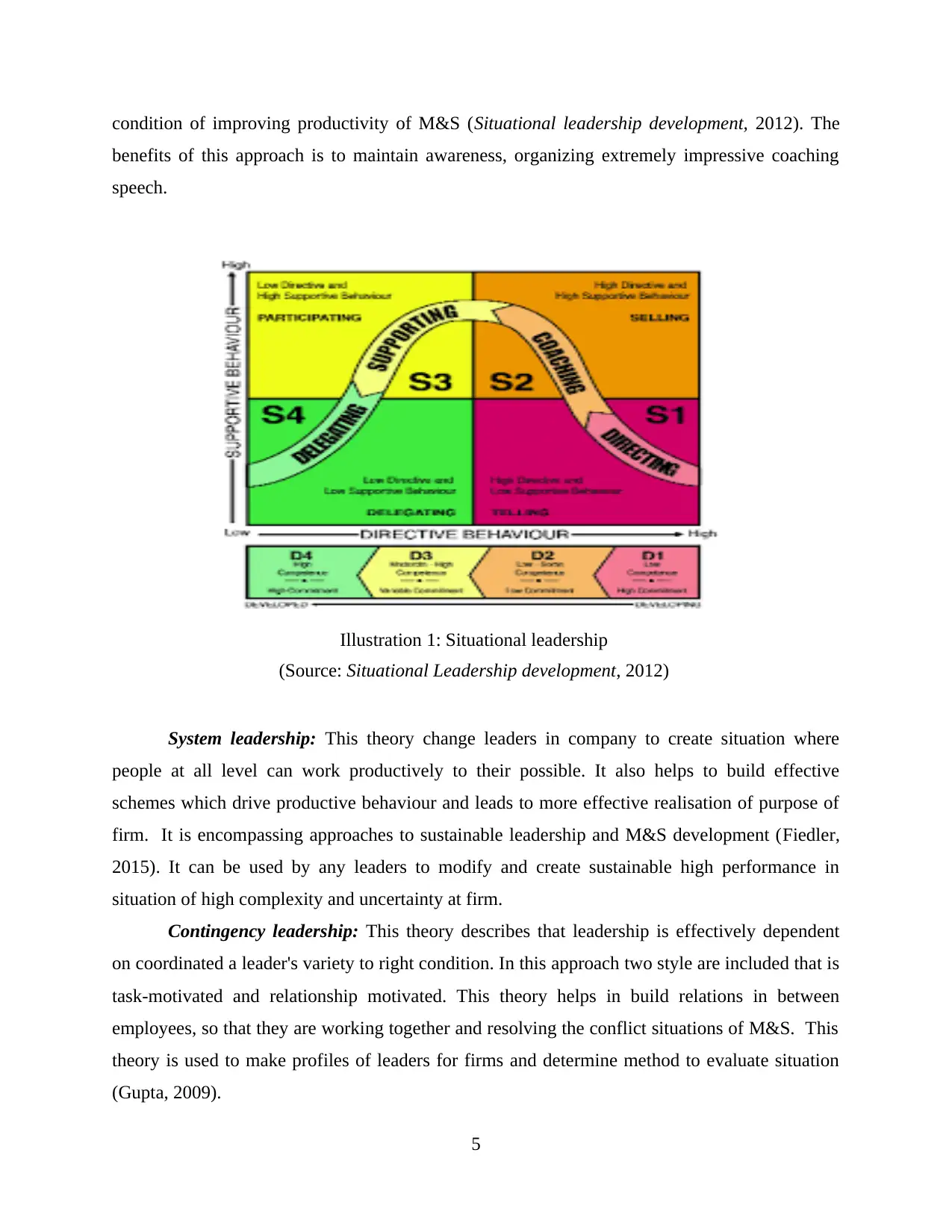
condition of improving productivity of M&S (Situational leadership development, 2012). The
benefits of this approach is to maintain awareness, organizing extremely impressive coaching
speech.
System leadership: This theory change leaders in company to create situation where
people at all level can work productively to their possible. It also helps to build effective
schemes which drive productive behaviour and leads to more effective realisation of purpose of
firm. It is encompassing approaches to sustainable leadership and M&S development (Fiedler,
2015). It can be used by any leaders to modify and create sustainable high performance in
situation of high complexity and uncertainty at firm.
Contingency leadership: This theory describes that leadership is effectively dependent
on coordinated a leader's variety to right condition. In this approach two style are included that is
task-motivated and relationship motivated. This theory helps in build relations in between
employees, so that they are working together and resolving the conflict situations of M&S. This
theory is used to make profiles of leaders for firms and determine method to evaluate situation
(Gupta, 2009).
5
Illustration 1: Situational leadership
(Source: Situational Leadership development, 2012)
benefits of this approach is to maintain awareness, organizing extremely impressive coaching
speech.
System leadership: This theory change leaders in company to create situation where
people at all level can work productively to their possible. It also helps to build effective
schemes which drive productive behaviour and leads to more effective realisation of purpose of
firm. It is encompassing approaches to sustainable leadership and M&S development (Fiedler,
2015). It can be used by any leaders to modify and create sustainable high performance in
situation of high complexity and uncertainty at firm.
Contingency leadership: This theory describes that leadership is effectively dependent
on coordinated a leader's variety to right condition. In this approach two style are included that is
task-motivated and relationship motivated. This theory helps in build relations in between
employees, so that they are working together and resolving the conflict situations of M&S. This
theory is used to make profiles of leaders for firms and determine method to evaluate situation
(Gupta, 2009).
5
Illustration 1: Situational leadership
(Source: Situational Leadership development, 2012)
Paraphrase This Document
Need a fresh take? Get an instant paraphrase of this document with our AI Paraphraser
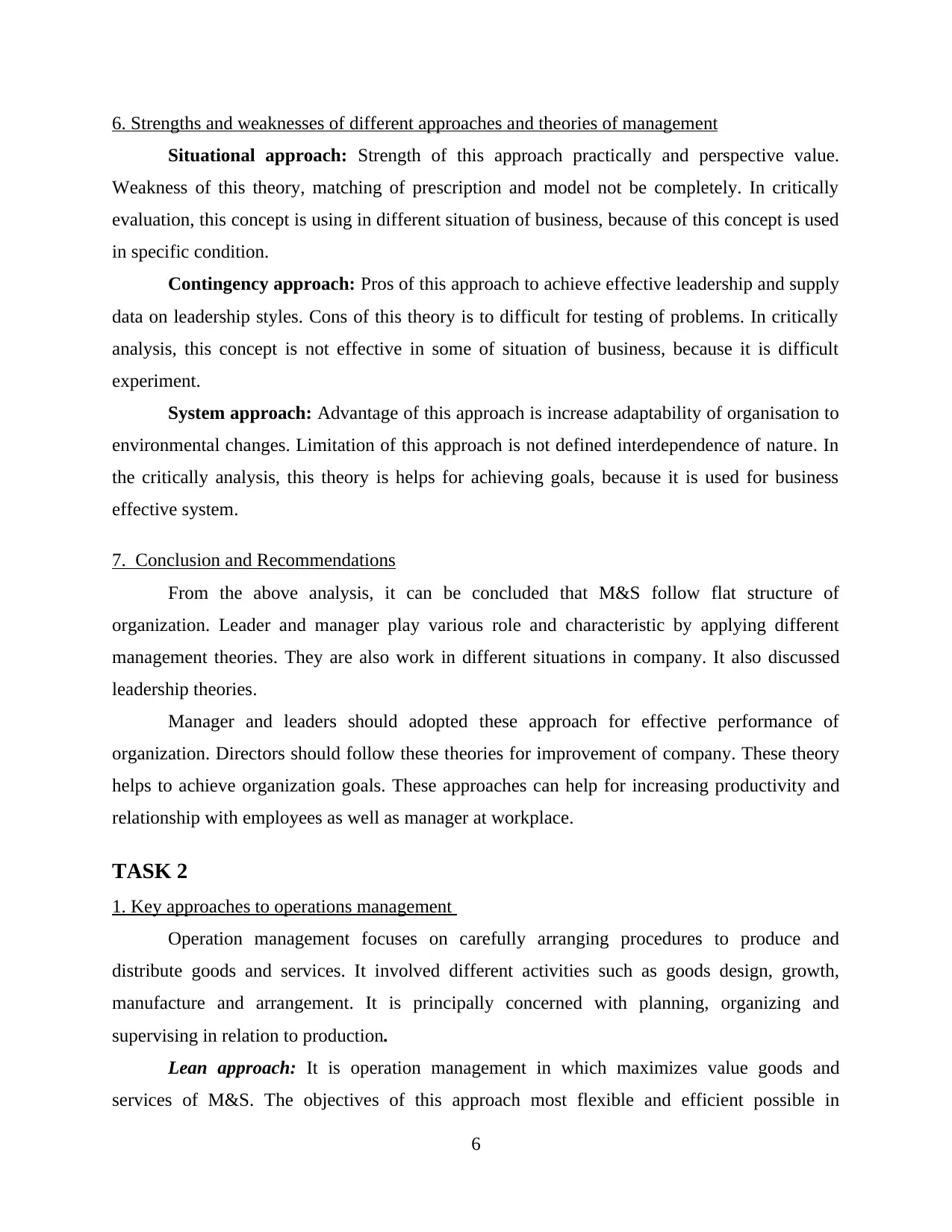
6. Strengths and weaknesses of different approaches and theories of management
Situational approach: Strength of this approach practically and perspective value.
Weakness of this theory, matching of prescription and model not be completely. In critically
evaluation, this concept is using in different situation of business, because of this concept is used
in specific condition.
Contingency approach: Pros of this approach to achieve effective leadership and supply
data on leadership styles. Cons of this theory is to difficult for testing of problems. In critically
analysis, this concept is not effective in some of situation of business, because it is difficult
experiment.
System approach: Advantage of this approach is increase adaptability of organisation to
environmental changes. Limitation of this approach is not defined interdependence of nature. In
the critically analysis, this theory is helps for achieving goals, because it is used for business
effective system.
7. Conclusion and Recommendations
From the above analysis, it can be concluded that M&S follow flat structure of
organization. Leader and manager play various role and characteristic by applying different
management theories. They are also work in different situations in company. It also discussed
leadership theories.
Manager and leaders should adopted these approach for effective performance of
organization. Directors should follow these theories for improvement of company. These theory
helps to achieve organization goals. These approaches can help for increasing productivity and
relationship with employees as well as manager at workplace.
TASK 2
1. Key approaches to operations management
Operation management focuses on carefully arranging procedures to produce and
distribute goods and services. It involved different activities such as goods design, growth,
manufacture and arrangement. It is principally concerned with planning, organizing and
supervising in relation to production.
Lean approach: It is operation management in which maximizes value goods and
services of M&S. The objectives of this approach most flexible and efficient possible in
6
Situational approach: Strength of this approach practically and perspective value.
Weakness of this theory, matching of prescription and model not be completely. In critically
evaluation, this concept is using in different situation of business, because of this concept is used
in specific condition.
Contingency approach: Pros of this approach to achieve effective leadership and supply
data on leadership styles. Cons of this theory is to difficult for testing of problems. In critically
analysis, this concept is not effective in some of situation of business, because it is difficult
experiment.
System approach: Advantage of this approach is increase adaptability of organisation to
environmental changes. Limitation of this approach is not defined interdependence of nature. In
the critically analysis, this theory is helps for achieving goals, because it is used for business
effective system.
7. Conclusion and Recommendations
From the above analysis, it can be concluded that M&S follow flat structure of
organization. Leader and manager play various role and characteristic by applying different
management theories. They are also work in different situations in company. It also discussed
leadership theories.
Manager and leaders should adopted these approach for effective performance of
organization. Directors should follow these theories for improvement of company. These theory
helps to achieve organization goals. These approaches can help for increasing productivity and
relationship with employees as well as manager at workplace.
TASK 2
1. Key approaches to operations management
Operation management focuses on carefully arranging procedures to produce and
distribute goods and services. It involved different activities such as goods design, growth,
manufacture and arrangement. It is principally concerned with planning, organizing and
supervising in relation to production.
Lean approach: It is operation management in which maximizes value goods and
services of M&S. The objectives of this approach most flexible and efficient possible in
6
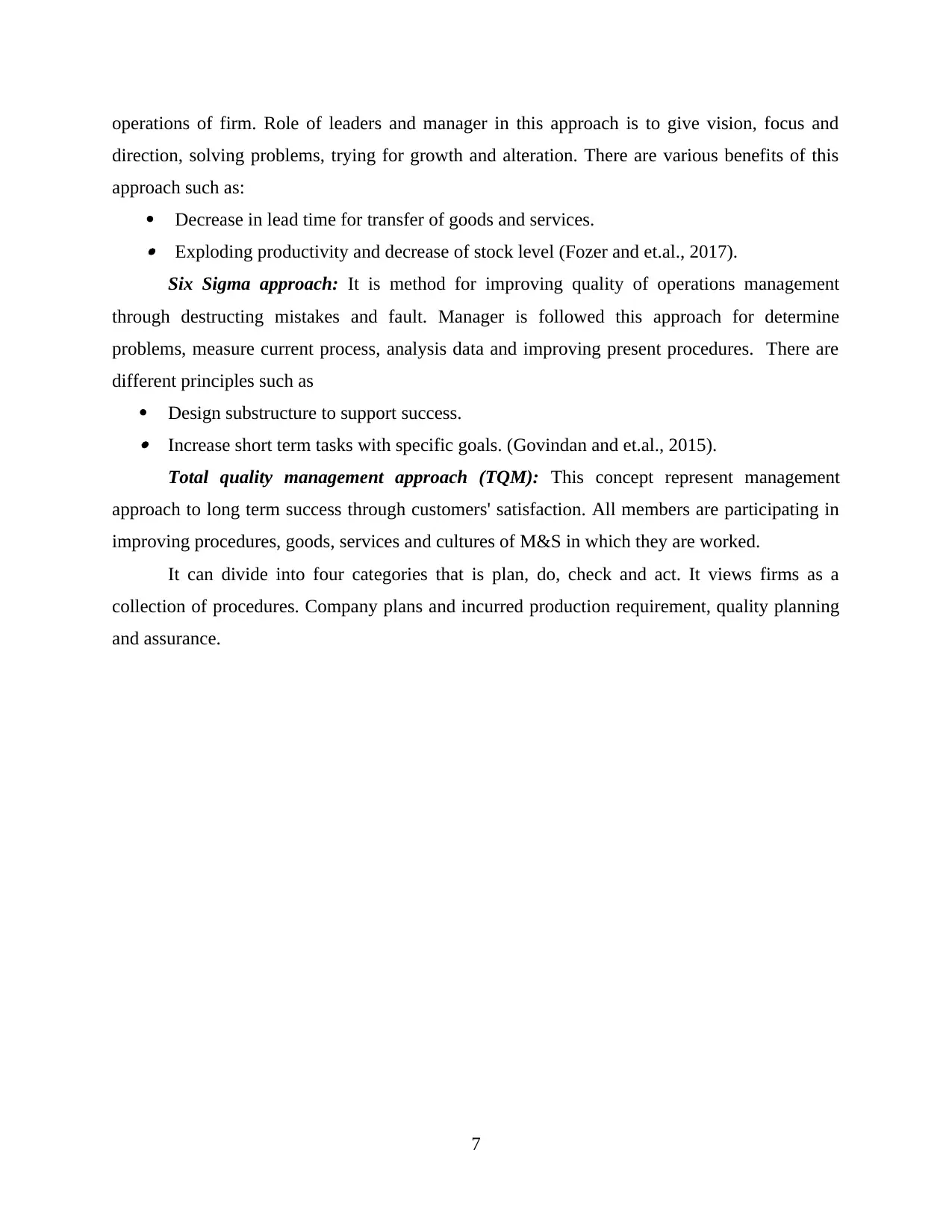
operations of firm. Role of leaders and manager in this approach is to give vision, focus and
direction, solving problems, trying for growth and alteration. There are various benefits of this
approach such as:
Decrease in lead time for transfer of goods and services. Exploding productivity and decrease of stock level (Fozer and et.al., 2017).
Six Sigma approach: It is method for improving quality of operations management
through destructing mistakes and fault. Manager is followed this approach for determine
problems, measure current process, analysis data and improving present procedures. There are
different principles such as
Design substructure to support success. Increase short term tasks with specific goals. (Govindan and et.al., 2015).
Total quality management approach (TQM): This concept represent management
approach to long term success through customers' satisfaction. All members are participating in
improving procedures, goods, services and cultures of M&S in which they are worked.
It can divide into four categories that is plan, do, check and act. It views firms as a
collection of procedures. Company plans and incurred production requirement, quality planning
and assurance.
7
direction, solving problems, trying for growth and alteration. There are various benefits of this
approach such as:
Decrease in lead time for transfer of goods and services. Exploding productivity and decrease of stock level (Fozer and et.al., 2017).
Six Sigma approach: It is method for improving quality of operations management
through destructing mistakes and fault. Manager is followed this approach for determine
problems, measure current process, analysis data and improving present procedures. There are
different principles such as
Design substructure to support success. Increase short term tasks with specific goals. (Govindan and et.al., 2015).
Total quality management approach (TQM): This concept represent management
approach to long term success through customers' satisfaction. All members are participating in
improving procedures, goods, services and cultures of M&S in which they are worked.
It can divide into four categories that is plan, do, check and act. It views firms as a
collection of procedures. Company plans and incurred production requirement, quality planning
and assurance.
7
⊘ This is a preview!⊘
Do you want full access?
Subscribe today to unlock all pages.

Trusted by 1+ million students worldwide
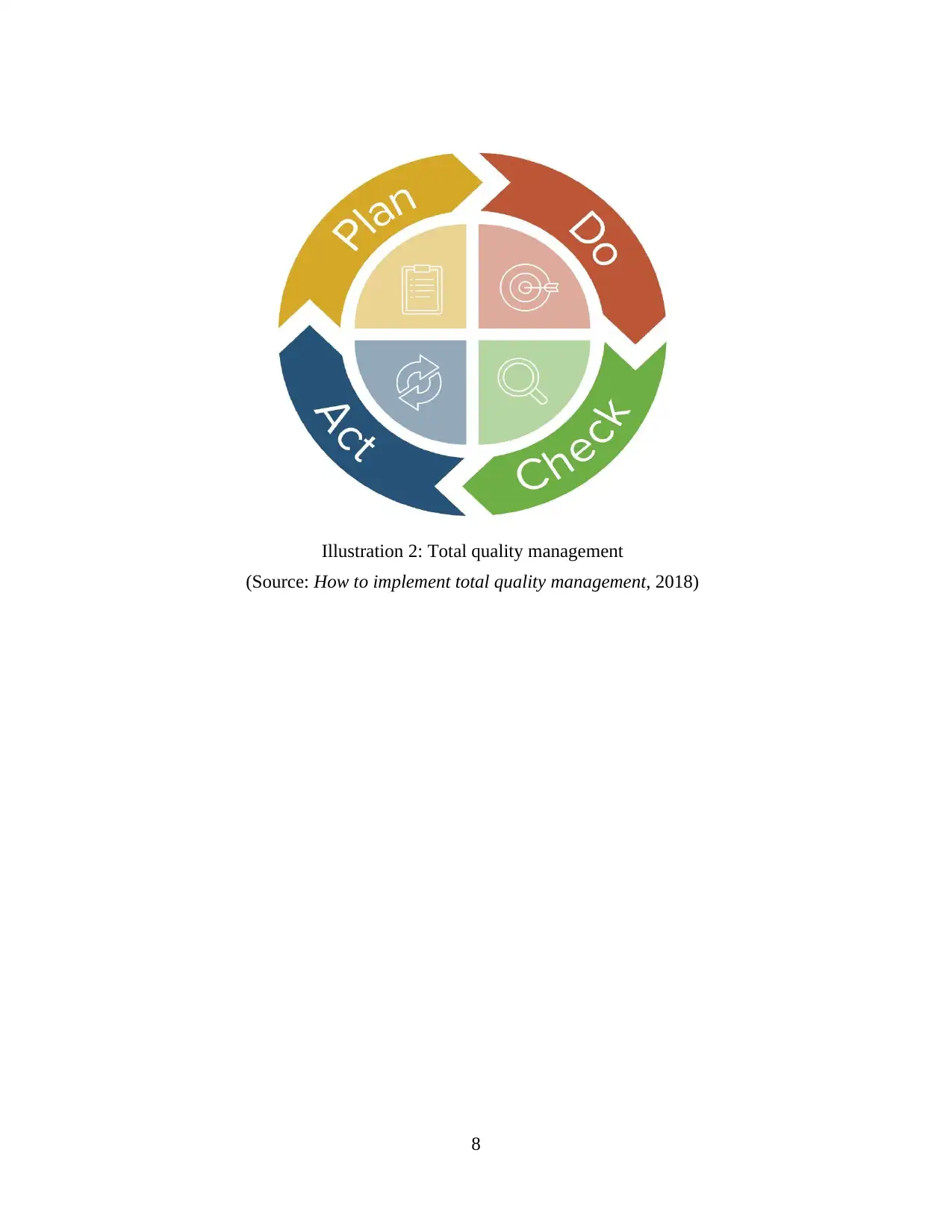
8
Illustration 2: Total quality management
(Source: How to implement total quality management, 2018)
Illustration 2: Total quality management
(Source: How to implement total quality management, 2018)
Paraphrase This Document
Need a fresh take? Get an instant paraphrase of this document with our AI Paraphraser
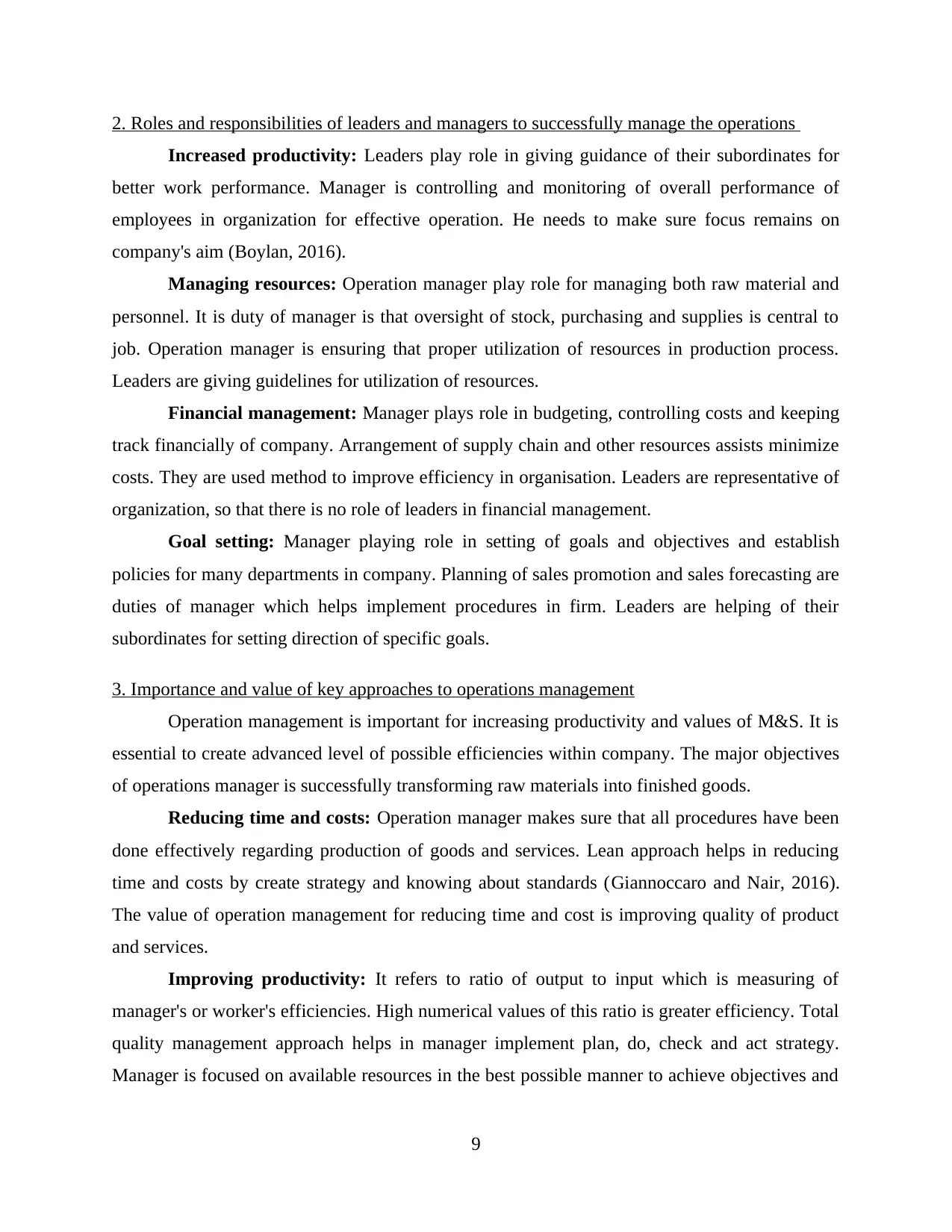
2. Roles and responsibilities of leaders and managers to successfully manage the operations
Increased productivity: Leaders play role in giving guidance of their subordinates for
better work performance. Manager is controlling and monitoring of overall performance of
employees in organization for effective operation. He needs to make sure focus remains on
company's aim (Boylan, 2016).
Managing resources: Operation manager play role for managing both raw material and
personnel. It is duty of manager is that oversight of stock, purchasing and supplies is central to
job. Operation manager is ensuring that proper utilization of resources in production process.
Leaders are giving guidelines for utilization of resources.
Financial management: Manager plays role in budgeting, controlling costs and keeping
track financially of company. Arrangement of supply chain and other resources assists minimize
costs. They are used method to improve efficiency in organisation. Leaders are representative of
organization, so that there is no role of leaders in financial management.
Goal setting: Manager playing role in setting of goals and objectives and establish
policies for many departments in company. Planning of sales promotion and sales forecasting are
duties of manager which helps implement procedures in firm. Leaders are helping of their
subordinates for setting direction of specific goals.
3. Importance and value of key approaches to operations management
Operation management is important for increasing productivity and values of M&S. It is
essential to create advanced level of possible efficiencies within company. The major objectives
of operations manager is successfully transforming raw materials into finished goods.
Reducing time and costs: Operation manager makes sure that all procedures have been
done effectively regarding production of goods and services. Lean approach helps in reducing
time and costs by create strategy and knowing about standards (Giannoccaro and Nair, 2016).
The value of operation management for reducing time and cost is improving quality of product
and services.
Improving productivity: It refers to ratio of output to input which is measuring of
manager's or worker's efficiencies. High numerical values of this ratio is greater efficiency. Total
quality management approach helps in manager implement plan, do, check and act strategy.
Manager is focused on available resources in the best possible manner to achieve objectives and
9
Increased productivity: Leaders play role in giving guidance of their subordinates for
better work performance. Manager is controlling and monitoring of overall performance of
employees in organization for effective operation. He needs to make sure focus remains on
company's aim (Boylan, 2016).
Managing resources: Operation manager play role for managing both raw material and
personnel. It is duty of manager is that oversight of stock, purchasing and supplies is central to
job. Operation manager is ensuring that proper utilization of resources in production process.
Leaders are giving guidelines for utilization of resources.
Financial management: Manager plays role in budgeting, controlling costs and keeping
track financially of company. Arrangement of supply chain and other resources assists minimize
costs. They are used method to improve efficiency in organisation. Leaders are representative of
organization, so that there is no role of leaders in financial management.
Goal setting: Manager playing role in setting of goals and objectives and establish
policies for many departments in company. Planning of sales promotion and sales forecasting are
duties of manager which helps implement procedures in firm. Leaders are helping of their
subordinates for setting direction of specific goals.
3. Importance and value of key approaches to operations management
Operation management is important for increasing productivity and values of M&S. It is
essential to create advanced level of possible efficiencies within company. The major objectives
of operations manager is successfully transforming raw materials into finished goods.
Reducing time and costs: Operation manager makes sure that all procedures have been
done effectively regarding production of goods and services. Lean approach helps in reducing
time and costs by create strategy and knowing about standards (Giannoccaro and Nair, 2016).
The value of operation management for reducing time and cost is improving quality of product
and services.
Improving productivity: It refers to ratio of output to input which is measuring of
manager's or worker's efficiencies. High numerical values of this ratio is greater efficiency. Total
quality management approach helps in manager implement plan, do, check and act strategy.
Manager is focused on available resources in the best possible manner to achieve objectives and
9
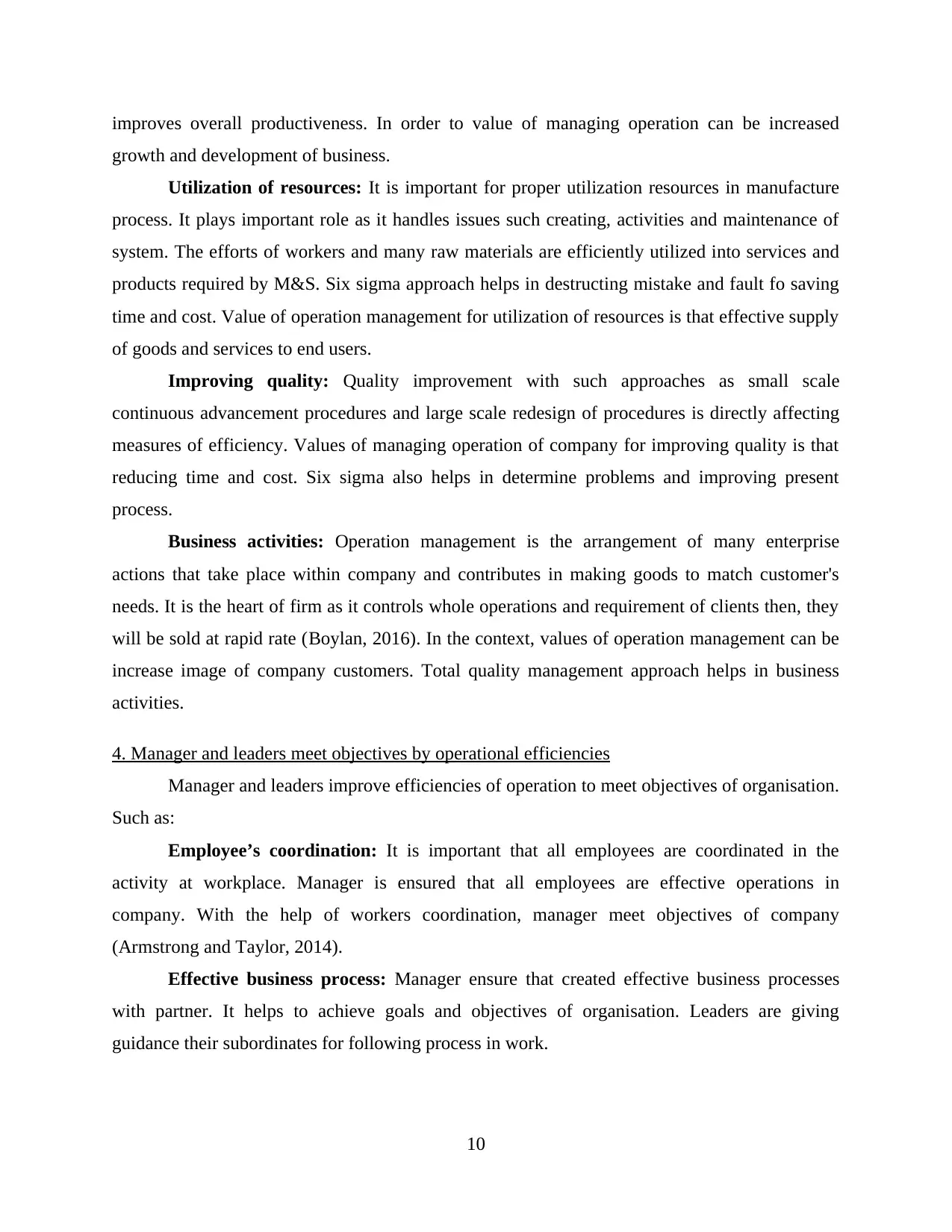
improves overall productiveness. In order to value of managing operation can be increased
growth and development of business.
Utilization of resources: It is important for proper utilization resources in manufacture
process. It plays important role as it handles issues such creating, activities and maintenance of
system. The efforts of workers and many raw materials are efficiently utilized into services and
products required by M&S. Six sigma approach helps in destructing mistake and fault fo saving
time and cost. Value of operation management for utilization of resources is that effective supply
of goods and services to end users.
Improving quality: Quality improvement with such approaches as small scale
continuous advancement procedures and large scale redesign of procedures is directly affecting
measures of efficiency. Values of managing operation of company for improving quality is that
reducing time and cost. Six sigma also helps in determine problems and improving present
process.
Business activities: Operation management is the arrangement of many enterprise
actions that take place within company and contributes in making goods to match customer's
needs. It is the heart of firm as it controls whole operations and requirement of clients then, they
will be sold at rapid rate (Boylan, 2016). In the context, values of operation management can be
increase image of company customers. Total quality management approach helps in business
activities.
4. Manager and leaders meet objectives by operational efficiencies
Manager and leaders improve efficiencies of operation to meet objectives of organisation.
Such as:
Employee’s coordination: It is important that all employees are coordinated in the
activity at workplace. Manager is ensured that all employees are effective operations in
company. With the help of workers coordination, manager meet objectives of company
(Armstrong and Taylor, 2014).
Effective business process: Manager ensure that created effective business processes
with partner. It helps to achieve goals and objectives of organisation. Leaders are giving
guidance their subordinates for following process in work.
10
growth and development of business.
Utilization of resources: It is important for proper utilization resources in manufacture
process. It plays important role as it handles issues such creating, activities and maintenance of
system. The efforts of workers and many raw materials are efficiently utilized into services and
products required by M&S. Six sigma approach helps in destructing mistake and fault fo saving
time and cost. Value of operation management for utilization of resources is that effective supply
of goods and services to end users.
Improving quality: Quality improvement with such approaches as small scale
continuous advancement procedures and large scale redesign of procedures is directly affecting
measures of efficiency. Values of managing operation of company for improving quality is that
reducing time and cost. Six sigma also helps in determine problems and improving present
process.
Business activities: Operation management is the arrangement of many enterprise
actions that take place within company and contributes in making goods to match customer's
needs. It is the heart of firm as it controls whole operations and requirement of clients then, they
will be sold at rapid rate (Boylan, 2016). In the context, values of operation management can be
increase image of company customers. Total quality management approach helps in business
activities.
4. Manager and leaders meet objectives by operational efficiencies
Manager and leaders improve efficiencies of operation to meet objectives of organisation.
Such as:
Employee’s coordination: It is important that all employees are coordinated in the
activity at workplace. Manager is ensured that all employees are effective operations in
company. With the help of workers coordination, manager meet objectives of company
(Armstrong and Taylor, 2014).
Effective business process: Manager ensure that created effective business processes
with partner. It helps to achieve goals and objectives of organisation. Leaders are giving
guidance their subordinates for following process in work.
10
⊘ This is a preview!⊘
Do you want full access?
Subscribe today to unlock all pages.

Trusted by 1+ million students worldwide
1 out of 17
Related Documents
Your All-in-One AI-Powered Toolkit for Academic Success.
+13062052269
info@desklib.com
Available 24*7 on WhatsApp / Email
![[object Object]](/_next/static/media/star-bottom.7253800d.svg)
Unlock your academic potential
Copyright © 2020–2025 A2Z Services. All Rights Reserved. Developed and managed by ZUCOL.





